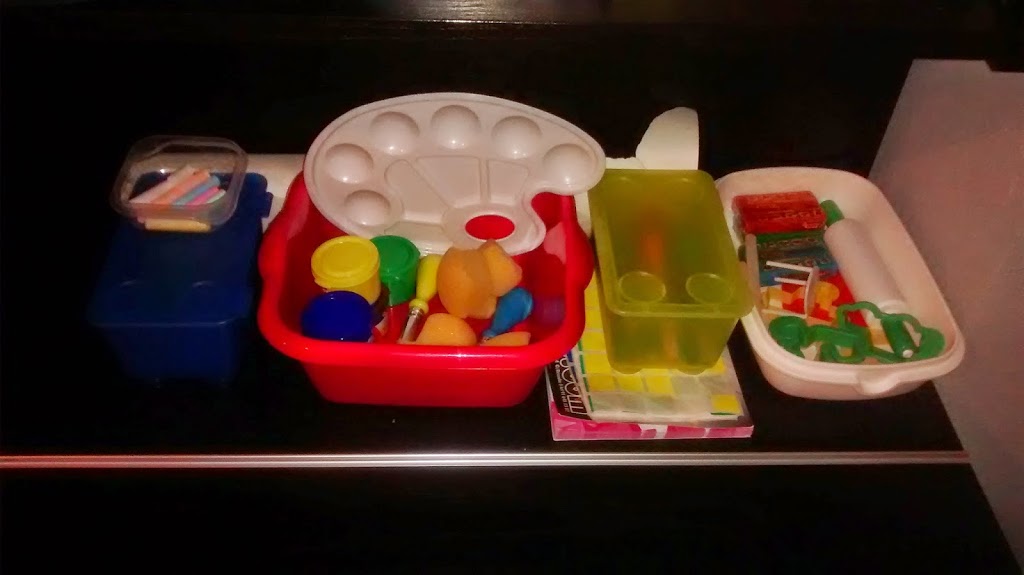Hace séis meses que empecé a escribir el blog, aunque al
principio era sólo para mis amigas, ha empezado a crecer y crecer, tanto
que todos los días tengo varías consultas en mi buzón de facebook y de
gmail. Me siento muy halagada, pero también abrumada porqué se me
acumulan y apenas tengo tiempo de contestar con una frase. Hay mensajes
realmente preciosos que me llenan el corazón y que de verás siento tener
que contestar tan escuetamente, cuando lo que me encantaría sería tomar
un café en un sitio kidfriendly con nuestros niños jugando cerquita.
Vengo observando que la mayoría de las cuestiones se repiten, espero que
con este post pueda responder a vuestras inquietudes.
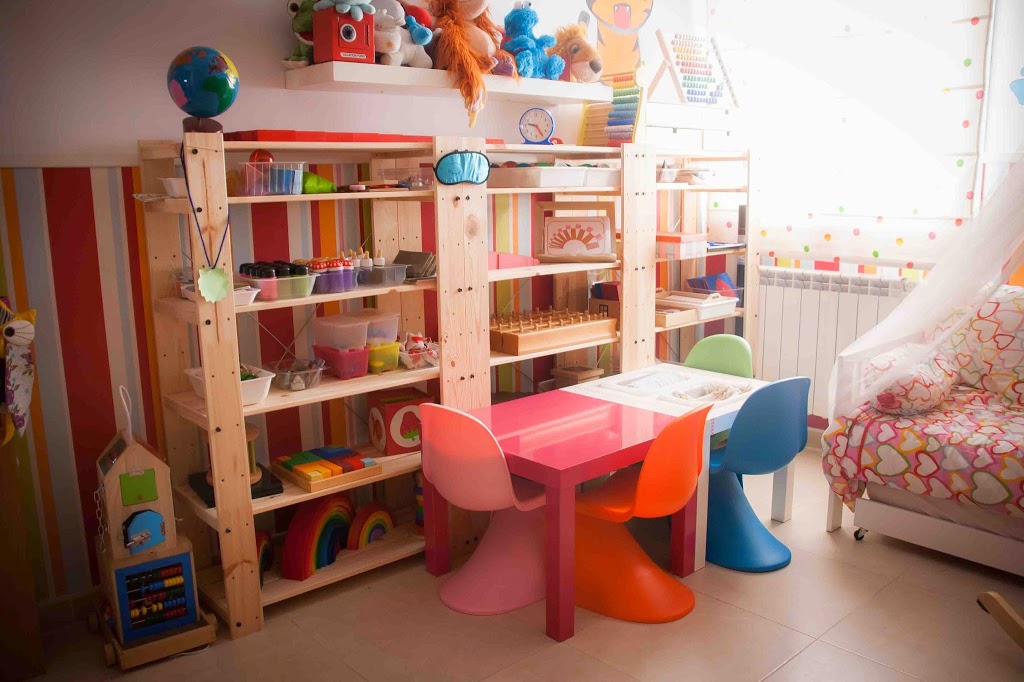
1) ¿Cómo empiezo con el Método Montessori?
Esta suele ser la pregunta más repetida. Desde que me llegó este post de ShikobaKids
siempre os lo enlazo. No puedo estar más de acuerdo con todo lo que
proponen desde este magnífico blog y no tengo nada más que añadir. Siempre os digo que observéis mucho a vuestros hijos como si fuéramos “un guardián entre el centeno”, sólo para proteger, sin intervenir, sin corregir, sin ayudar. Sólo de esta observación podremos seguir la máxima de María Montessori “Sigue al niño”.

2) ¿Qué lecturas me recomiendas sobre el Método Montessori? ¿Dónde me puedo formar?
Siempre cuento que yo llegué a Montessori gracias a la necesidad de
autonomía de Abril. Su interés por valerse por sí misma sin ayuda ha
marcado nuestra crianza, buscando información para favorecerlo, me tope
con la filosofía Montessori, realice una búsqueda en mi biblioteca y me
llevé dos libros “Como obtener lo mejor de tus hijos” de Tim Seldin (estupendo pero está descatalogado) y el maravilloso “Enséñame a hacerlo sin tu ayuda” de Maja Pitamic. Sé que hay otro libro en inglés “Montessori from the Start”,
pero la verdad es que no le he leído, hay críticas de todo tipo y no me
atrevo a recomendarlo sin leerlo primero, pero si alguien se quiere
animar, le dejo el enlace.

Éstos libros abrieron mi mente y mi corazón, luego hice la formación
con Colette y me terminé de enamorar, también comencé a formarme en
inglés con KHT Montessori y acabo de empezar Montessori From the Earth
de Lisa Nolan. En España hay varias formaciones para familias (Colette
Parent, Celine Haumery y Jaisa Educativos) y también para profesionales
(Universidad de Vic, Montessori Figueres, Montessori Canela y Guadalupe
Barbolla en Valencia, Galicia y próximamente Madrid).
3) ¿Cómo se trata el sueño, el destete, la alimentación complementaria y el control de esfínteres según el Método Montessori?
Muchos me escribís también porqué habéis leído que María Montessori
estaba en contra del colecho y la lactancia más allá de los 9 meses.
Sinceramente no sé de donde sale esa información, yo no lo he leído en
sus escritos (bien es verdad que tengo muchísimo pendiente por leer),
pero aunque así fuera, hay que saber relativizar y poner las cosas en su
contexto. Hace 100 años no se sabía lo que hoy se sabe sobre lactancia
materna, María Montessori era ante todo científica y si hoy viviera
estoy segura de que su postura sería la misma que la de la OMS. Si es
verdad que la pedagogía Montessori propone animar a los niños a comer
solos, en unas mesitas y sillas bajas (en las escuelas, para un hogar a mí me parecen más apropiadas las tronas evolutivas como la nuestra). Nuestras niñas han comenzado la alimentación complementaria de forma autorregulada, Baby Led Weaning en ingles. Existe un libro de Gill Rapley estupendo, en inglés y traducido al español. Y estoy segura de no equivocarme diciendo que mi amiga Eloísa es la mayor experta en BLW de nuestro país, os invito a su blog Una Maternidad Diferente.
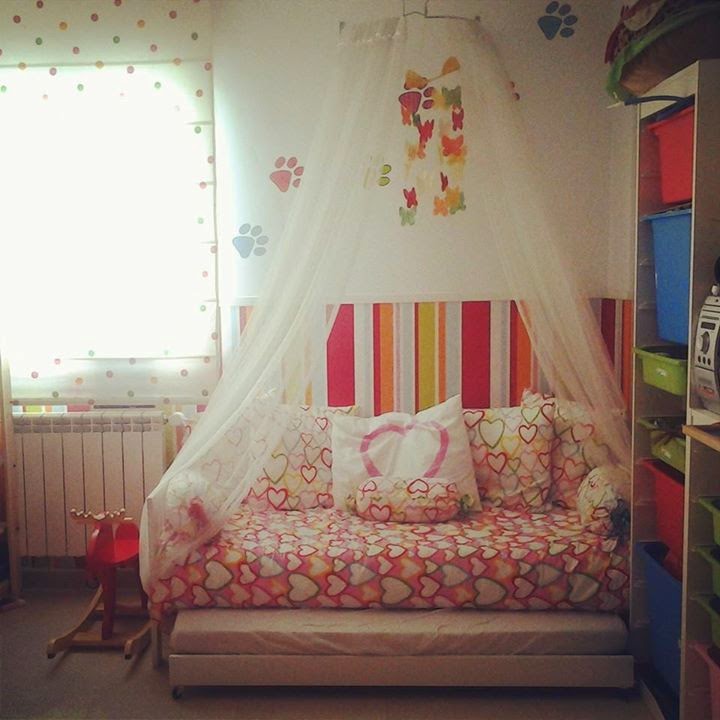
Dentro de la filosofía Montessori, también son habituales unas camitas en el suelo
para que duerman los pequeños cuando ellos se sientan cansados, pero a
mi me parece una alternativa a las cunas de barrotes, no a la cama
familiar. Nosotros tenemos dos camitas a su altura que solo usan para
alguna siesta, pero estoy segura de que estas camitas pueden ser la
alternativa perfecta a la cuna de barrotes de muchas familias.
Finalmente, sobre el control de esfínteres, la filosofía Montessori promueve que sea el niño quien decida cuando y como quiere dejar el pañal, no que sus padres unilateralmente, seamos quienes decidamos el momento y la forma de hacerlo. Se habla en inglés de toilet learning, no de toilet training.
Se crea un ambiente preparado en el baño para que tenga capacidad para
ir al wc u orinal sin depender de nadie y jamás se reprende al pequeño
si hay escapes, no hay nada más autocorrectivo que hacerse pis encima.
Todas estas cuestiones son en el fondo de crianza, no de
pedagogía. La máxima Montessori es “Sigue al niño” y eso incluye su
contexto familiar. Cualquier decisión reflexionada y tomada desde el
amor y el cariño es buena para los pequeños, sea cual sea. No
permitas que nadie te cuestione o te juzgue, sea cual sea tu opción. Si
en algún momento no te sientes cómodo, plantéate si es algo interno,
entonces cambía lo que te molesta, o externo, entonces créate una
burbuja de paz en la que sólo pueda entrar tu familia. El resto del
mundo no tiene NADA que decir.
4)¿Cómo se resuelven los conflictos según el Método Montessori? ¿Se castiga a los niños? ¿Se les premia?
Siempre se resuelven los conflictos sin castigar, sin gritar, sin
amenazar y, en la medida de lo posible, sin intervenir. En el post que
escribí sobre como fomentar la autonomía de los niños ya os adelantaba algo sobre la mesa de la paz, un recurso magnifico para resolver pacíficamente los conflictos.
Esto es lo que se propone en la pedagogía Montessori, lo que sigue a continuación es mi opinión personal al respecto. No quiero que nadie entienda que considero que los niños deberían crecer sin límites – libertad no es lo mismo que libertinaje-,
mis hijas tienen pocos límites pero muy claros y bastante inflexibles.
Yo me refiero a que en la medida de lo posible, ante las acciones
inadecuadas de nuestros hijos les hagamos saber las consecuencias
naturales (podemos dejarles descubrir que si estropea un juguete no
podrá jugar más con él, pero no podemos dejarles experimentar las
consecuencias de cruzar la carretera solos sin mirar).
 Me
escribís mucho sobre cómo actuar cuando nuestros hijos se pelean en el
parque, yo no soy psicóloga, sólo una simple mamá, pero siempre os digo
lo mismo, cuando se trata de niños muy pequeños, lo mejor es distraer
porque aún no han desarrollado la suficiente empatía. Por supuesto no
podemos tolerar ningún tipo de violencia, ni verbal, ni mucho menos
física. Debemos intervenir siempre con suavidad, sin buscar culpables
(cuando hay una agresión ambos niños se sienten mal, decir “no se
muerde” o “no se pega” en un momento de tensión no sólo sirve de nada
sino que además es bastante injusto para los niños), separarles con un
simple “No podemos permitir que os hagáis daño” y quizás guiarles hacia a
algún juego de corro para que gracias al movimiento y el juego
cooperativo se disipe la tensión.
Me
escribís mucho sobre cómo actuar cuando nuestros hijos se pelean en el
parque, yo no soy psicóloga, sólo una simple mamá, pero siempre os digo
lo mismo, cuando se trata de niños muy pequeños, lo mejor es distraer
porque aún no han desarrollado la suficiente empatía. Por supuesto no
podemos tolerar ningún tipo de violencia, ni verbal, ni mucho menos
física. Debemos intervenir siempre con suavidad, sin buscar culpables
(cuando hay una agresión ambos niños se sienten mal, decir “no se
muerde” o “no se pega” en un momento de tensión no sólo sirve de nada
sino que además es bastante injusto para los niños), separarles con un
simple “No podemos permitir que os hagáis daño” y quizás guiarles hacia a
algún juego de corro para que gracias al movimiento y el juego
cooperativo se disipe la tensión.
Sobre los premios y los castigos, el otro día compartí un enlace de Alfie Kohn
y algunos me hicisteis saber que no os había gustado. La visión de la
educación que tiene este divulgador a mi me parece excepcional, estoy
profundamente de acuerdo con este artículo, que tuve la suerte de leer
cuando Abril tenía unos meses de vida. Creo firmemente que los
premios y los castigos son peligrosos en la crianza, principalmente
porque nuestros hijos nos adoran y con el conductismo podemos conseguir
que se comporten como queramos que sean y no como genuinamente son.
Sí, los premios también, el conductismo no existe sin los refuerzos
positivos. Necesito tener un rato de tranquilidad y silencio para poder
desarrollar mi opinión al respecto sin ofender a nadie, porque no es mi
intención en absoluto. Mis padres me educaron así y lo hicieron genial,
pero hoy en día hay recursos para hacer las cosas de forma distinta y
así lo estamos haciendo nosotros. Algunos libros que me encantan al
respecto son estos: El cerebro del niño, Aprender a educar sin gritos, amenazas, ni castigos, Crianza Incondicional, y,especialmente para hermanos, Querer a todos por igual.
5) ¿Permite la fantasía y el juego simbólico el Método Montessori?
No, en líneas generales, en las Escuelas Montessori, no se fomenta ni la
fantasía ni el juego simbólico. De nuevo me gustaría tomar una
perspectiva histórica, hace 100 años, los cuentos de fantasía se
utilizaban para atemorizar a los niños y manipularles para evitar o
incentivar ciertos comportamientos. No trataban sobre preciosos
unicornios que galopaban por el arco iris, sino sobre brujas que se
comían a los niños que se perdían en el bosque. La visión de la
infancia que tenía María Montessori es totalmente contraría a esto, así
que por coherencia, es lógico pensar que estuviera en contra de los
cuentos de fantasía. Por otro lado, opinaba que el deseo de fantasía de
los niños era debido a anhelaban el verdadero conocimiento científico
-que se les negaba porque en aquella época se consideraba que no podrían
comprender tan pequeños-. Algo parecido ocurría con el juego simbólico,
María Montessori pensaba que el juego heurístico era el único que
recurso que tenían los pequeños para imitar a los adultos, por lo que
considera que esa necesidad de por ejemplo jugar a las cocinitas para
emular a los adultos se suplía con las actividades de vida práctica que
proponía.

Sobre esto hay mucho que discutir, creo que es lógico que en las
Escuelas Montessori no se impulsen ni la fantasía ni el juego simbólico.
También creo que en una casa es imposible, primero porque a los niños
les encanta y están mucho tiempo en casa – en la escuela solo unas
horas-, y segundo porque desde que nacen (el contexto social ha cambiado mucho en los últimos 100 años) se ven expuestos a la fantasía. Ya os conté que “en mi casa jugamos así” en este artículo. Sigue al niño es la máxima 🙂

6) ¿Cómo organizo mi casa según el Método Montessori?
Ésta es otra pregunta estrella y me es imposible dar una respuesta
adecuada, porque cada casa y cada familia es un mundo. En este enlace compartí unas sugerencias que di a una lectora, en este otro enlace explique cómo organizamos el tiempo en nuestra casa, y en este otro os explique el contenido de nuestras estanterías.
Cada casa es distinta y es necesario que estemos todos cómodos,
nosotros estamos todo el rato cambiando cosas. El otro día sorprendí a
Abril jugando a “pensar la casa”, cogía el metro medía algún mueble, se
sentaba y se ponía un dedo sobre la barbilla y miraba al infinito.
Intento no intervenir pero no pude reprimir la carcajada jeje tu hijo es
tu espejo 🙂
Organizamos el trabajo en bandejas para que sea más fácil concentrarse y
limpiar en caso de accidentes, se utilizan las esterillas para poder
delimitar el espacio de trabajo, el orden en casa se relaciona con el
periodo sensible para el orden que tienen los peques en su temprana
infancia. Piensa mucho como quieres distribuir tu casa, experimenta,
cambia, no tengas miedo a equivocarte y dar un paso atrás. El ensayo y
error es la clave.
 Me
gustaría reflexionar, en relación al punto 4 sobre este temor a
equivocarnos, creo que viene dado porqué en nuestra infancia jamás se
nos ha inculcado el valor del error como el motor del aprendizaje. Se
nos ha premiado con los “muy bien” pero jamás nos han dicho (a mí por lo
menos) “Genial, te has equivocado, sigue practicando y pronto lograrás
lo que quieres”.
Me
gustaría reflexionar, en relación al punto 4 sobre este temor a
equivocarnos, creo que viene dado porqué en nuestra infancia jamás se
nos ha inculcado el valor del error como el motor del aprendizaje. Se
nos ha premiado con los “muy bien” pero jamás nos han dicho (a mí por lo
menos) “Genial, te has equivocado, sigue practicando y pronto lograrás
lo que quieres”.
7) ¿Por qué son importantes las actividades de vida práctica según el Método Montessori?
Aunque hay gente que puede considerar que son sexistas, ya explique en
este enlace mi opinión al respecto. Son muy importantes por varias
cosas: Favorecen la concentración, la autonomía y el aprendizaje
empírico por repetición, ensayo y error, además se favorece el
autocontrol y el desarrollo de los músculos de las manos (de las muñecas
y la pinza de los dedos). Saber cuidarse solos es lo más valioso a mi
juicio, y además es prácticamente gratis, un aprendizaje que les
acompañará toda la vida. La sensación de autonomía favorece su
autoestima, lo que le ayudará a conseguir grandes retos como por ejemplo
aprender a leer.
También me comentais que Montessori os parece demasiado directivo, es
verdad que hay una serie de pasos muy estudiados que se parecen más a un
ritual que a la realización de una actividad cotidiana, pero conviene
recordar que los pasos de la presentación que realiza el guía, son solo
un modelo que el niño reproduce, nunca NUNCA se corrige el error del pequeño, simplemente se repite la presentación si es necesario.
Me gustaría poner un ejemplo, si yo quiero hacer un guiso y no sé
cocinar y mi madre me dice “simplemente rehoga el sofrito y luego añades
la falda” (muy típico de madre, ¿verdad? :P) , probablemente me saldrá
algo incomible. Sin embargo, si leo una receta bien explicada o veo un
programa de Arguiñano, las posibilidades de éxito son mayores, eso no
significa que yo no pueda innovar y utilizar calabacín en vez de
berenjena o que corté las patatas en tiras en vez de láminas. Según mi
forma de entender el espíritu Montessori no tiene sentido decirle al
niño como, cuando y de que manera se utiliza un material determinado y
si el niño no juega exactamente como consideramos, regañarle (salvo que
no respete el material o a los compañeros, claro).
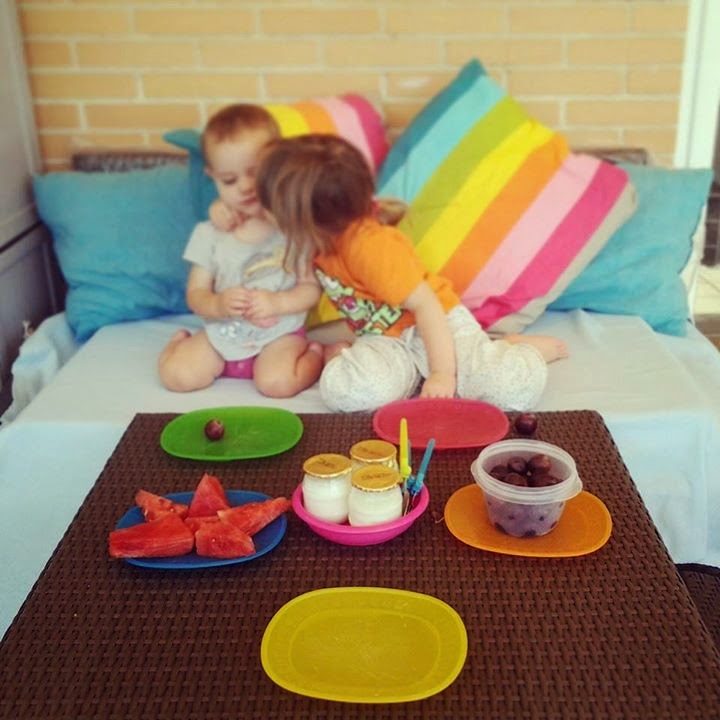
8) ¿Cómo aprenden matemáticas los niños con el Método Montessori?
Otra de las máximas Montessori es el aprendizaje de lo fácil a lo
difícil, de lo concreto a lo abstracto y siempre aislando la dificultad.
Por eso los materiales Montessori son manipulativos. Antes de proponer a
los niños materiales propiamente Montessori (en este orden, listones
rojos y azules, números de lija, caja de husos, numerales y contadores,
etc.) es necesario que realicen previamente una serie de actividades:
Aprender la correspondencia 1-1, clasificación, conocer libros y
canciones de contar y juegos de secuencias. Nada de esto es difícil o
caro de conseguir, ¿verdad?
Cuando aprenden matemáticas, los niños utilizan las dos manos (por
ejemplo manejando un ábaco), lo que implica activar ambos hemisferios
cerebrales y en consecuencia un aprendizaje integral. Hoy la ciencia
confirma algo que la Dra. Montessori intuía simplemente observando a los
niños.
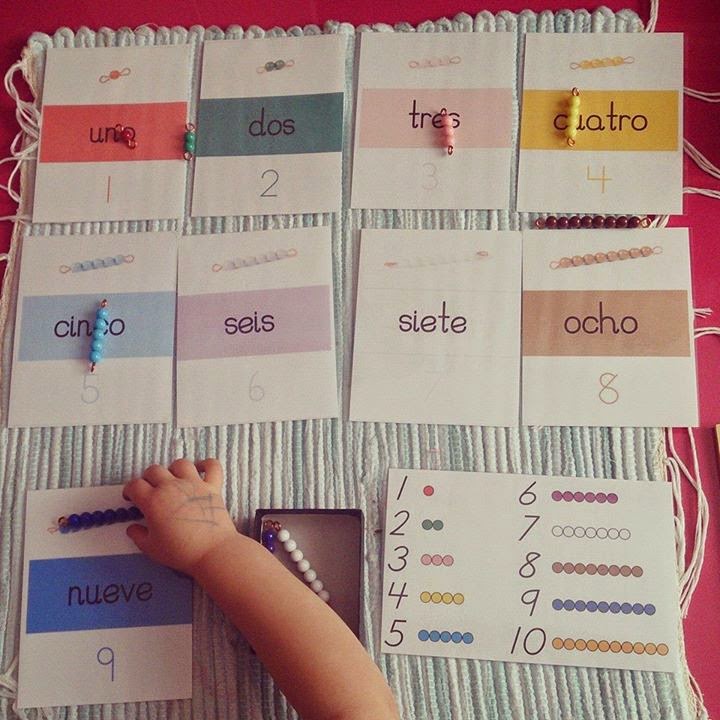
No es necesario que los materiales sean Montessori para que sean manipulativos. Malena de Aprendiendo Matemáticas propone estupendos cursos
para familias y muestra como desarrollar materiales caseros DIY a bajo
precio, os animo a visitar su web.
9) ¿Cómo aprenden lectoescritura los niños con el Método Montessori?
En el mundo de la educación respetuosa hay una cierta polémica respecto a
cuál es la edad adecuada para enseñar a leer a los niños. La pedagogía
Waldorf y los países nórdicos apuestan porque no se les enseñe a los
niños a leer hasta los 6-7 años, hasta esa edad lo más importante es el
juego libre. El periodo sensible según Montessori para aprender a leer
es anterior. Personalmente pienso que ambas posturas llevan razón.
Creo firmemente en el juego libre durante estos primeros años, pero
también sé que hay niños que QUIEREN leer en su primera infancia. He
visto a mi hermano pequeño llorar de frustración porque quería leer
como el resto de la familia, lo consiguió con 4 años y con el método
silábico tradicional. Las capacidades y la voluntad van siempre juntas, a
veces de la mano, pero a veces se tocan solo con los dedos. Si bien es
cierto que la completa madurez de los niños es a los 7 años, os recuerdo
que la máxima Montessori es seguir al niño, tanto al que quiere
aprender con 4 como el que desea hacerlo mas tarde. No se fuerza el aprendizaje.
Aprender a leer es un proceso complejo para niños pequeños; Montessori
permite aislar la dificultad y ajustar el deseo de conocimiento con las
habilidades de los pequeños: Por ejemplo, como aún no puede sostener del
todo bien el lápiz y tener fuerza para escribir, se utiliza un alfabeto
móvil para que pueda escribir a la velocidad que va su cerebro, no su
mano. . Se aprende a escribir paralelamente (normalmente un poco antes )
que a leer, se utilizan materiales manipulativos (letras de lija,
bandeja de sémola y alfabeto móvil) porque los pequeños aprenden con la
información que le transmiten sus sentidos. Os recomiendo encarecidamente el Libro de Lynne Lawrence. Y leed mucho, MUCHISIMO a vuestros hijos

10) ¿Por qué son tan caros los materiales del Método Montessori? ¿Dónde compro materiales?
Los materiales oficiales de Nienhius si son carísimos, son especiales
para las escuelas por su calidad y su precisión extrema, pero nosotros
bien los fabricamos caseros, bien los compramos a Jaisa Educativos,
que tienen una calidad relación precio excepcional. Sandra tiene un
gran conocimiento sobre los materiales de Montessori, Waldorf y diversos
métodos educativos, está formada en Pedagogía Blanca y además ofrece cursos por toda España. El proyecto sostenible que propone me parece digno de admirar
y además colaboro en su web desarrollando contenidos. Es por eso que
siempre os recomiendo su web para comprar materiales. También tienen
preciosos juguetes de madera para los niños, así como juegos de
exterior. Hay otros materiales, sobre todo para la mesa de luz, libros y
demás, que solemos comprar en Amazon. También en Book Depository si son
antiguos y/o están descatalogados.
 También me preguntáis por Aliexpress, he comprado algunas cosas: Mini cilindros, Mini torre rosa, puzles, un binomio, un alfabeto móvil y una bolsa misteriosa.
No repetiría, es verdad que te ahorras dinero, pero tarda mucho en
venir, a veces paran las cosas en Aduanas (si compráis os recomiendo que
dividáis los envíos) y además los materiales no son tan buenos como los
de Jaisa y las descripciones llevan a error (o directamente estafa como
me paso con la Torre Rosa, que después de una disputa me devolvieron el
dinero). Los mini cilindros son muy bonitos y la diferencia de precio
con los verdaderos es abismal, pero son tan fáciles que enseguida se
cansa Abril, el binomio sigue oliendo a plástico, la bolsa misteriosa
tiene los sólidos demasiado pequeños para tener una percepción sensorial
adecuada. Los puzzles están bien por ese dinero y el alfabeto móvil si
nos gusta mucho, ¡pero me estoy volviendo loca para hacerle una caja!
También me preguntáis por Aliexpress, he comprado algunas cosas: Mini cilindros, Mini torre rosa, puzles, un binomio, un alfabeto móvil y una bolsa misteriosa.
No repetiría, es verdad que te ahorras dinero, pero tarda mucho en
venir, a veces paran las cosas en Aduanas (si compráis os recomiendo que
dividáis los envíos) y además los materiales no son tan buenos como los
de Jaisa y las descripciones llevan a error (o directamente estafa como
me paso con la Torre Rosa, que después de una disputa me devolvieron el
dinero). Los mini cilindros son muy bonitos y la diferencia de precio
con los verdaderos es abismal, pero son tan fáciles que enseguida se
cansa Abril, el binomio sigue oliendo a plástico, la bolsa misteriosa
tiene los sólidos demasiado pequeños para tener una percepción sensorial
adecuada. Los puzzles están bien por ese dinero y el alfabeto móvil si
nos gusta mucho, ¡pero me estoy volviendo loca para hacerle una caja!
Espero haberos ayudado, os animo a pedir acceso a nuestro grupo de Facebook “Montessori con ñ“, somos mil personas con ganas de aprender mucho, materiales que compartimos y también dudas.
Y os dejo con ésta cita que me apasiona.
“Muchas veces me imagino que hay un montón de niños jugando en un
campo de centeno. Miles de niños. Y están solos, quiero decir que no hay
nadie mayor vigilándolos. Sólo yo. Estoy al borde de un precipicio y mi
trabajo consiste en evitar que los niños caigan a él. En cuanto
empiezan a correr sin mirar adonde van, yo salgo de donde esté y los
cojo. Eso es lo que me gustaría hacer todo el tiempo. Vigilarlos. Yo
sería el guardián entre el centeno. Te parecerá una tontería, pero es lo
único que de verdad me gustaría hacer. Sé que es una locura”.
Bendita locura y feliz aprendizaje 🙂

Links afiliados (Recibimos una pequeña comisión si compras a través de ellos). Ayúdanos a seguir tigriteando 🙂


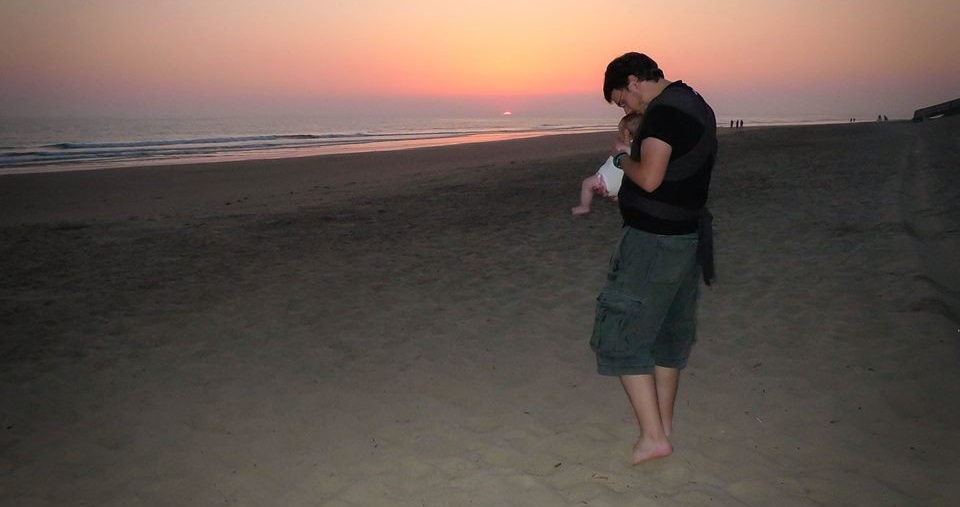


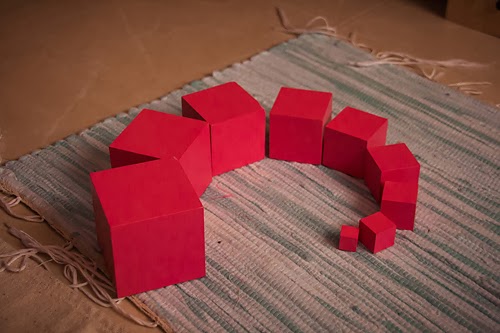




 Me
escribís mucho sobre cómo actuar cuando nuestros hijos se pelean en el
parque, yo no soy psicóloga, sólo una simple mamá, pero siempre os digo
lo mismo, cuando se trata de niños muy pequeños, lo mejor es distraer
porque aún no han desarrollado la suficiente empatía. Por supuesto no
podemos tolerar ningún tipo de violencia, ni verbal, ni mucho menos
física. Debemos intervenir siempre con suavidad, sin buscar culpables
(cuando hay una agresión ambos niños se sienten mal, decir “no se
muerde” o “no se pega” en un momento de tensión no sólo sirve de nada
sino que además es bastante injusto para los niños), separarles con un
simple “No podemos permitir que os hagáis daño” y quizás guiarles hacia a
algún juego de corro para que gracias al movimiento y el juego
cooperativo se disipe la tensión.
Me
escribís mucho sobre cómo actuar cuando nuestros hijos se pelean en el
parque, yo no soy psicóloga, sólo una simple mamá, pero siempre os digo
lo mismo, cuando se trata de niños muy pequeños, lo mejor es distraer
porque aún no han desarrollado la suficiente empatía. Por supuesto no
podemos tolerar ningún tipo de violencia, ni verbal, ni mucho menos
física. Debemos intervenir siempre con suavidad, sin buscar culpables
(cuando hay una agresión ambos niños se sienten mal, decir “no se
muerde” o “no se pega” en un momento de tensión no sólo sirve de nada
sino que además es bastante injusto para los niños), separarles con un
simple “No podemos permitir que os hagáis daño” y quizás guiarles hacia a
algún juego de corro para que gracias al movimiento y el juego
cooperativo se disipe la tensión.

 Me
gustaría reflexionar, en relación al punto 4 sobre este temor a
equivocarnos, creo que viene dado porqué en nuestra infancia jamás se
nos ha inculcado el valor del error como el motor del aprendizaje. Se
nos ha premiado con los “muy bien” pero jamás nos han dicho (a mí por lo
menos) “Genial, te has equivocado, sigue practicando y pronto lograrás
lo que quieres”.
Me
gustaría reflexionar, en relación al punto 4 sobre este temor a
equivocarnos, creo que viene dado porqué en nuestra infancia jamás se
nos ha inculcado el valor del error como el motor del aprendizaje. Se
nos ha premiado con los “muy bien” pero jamás nos han dicho (a mí por lo
menos) “Genial, te has equivocado, sigue practicando y pronto lograrás
lo que quieres”.












